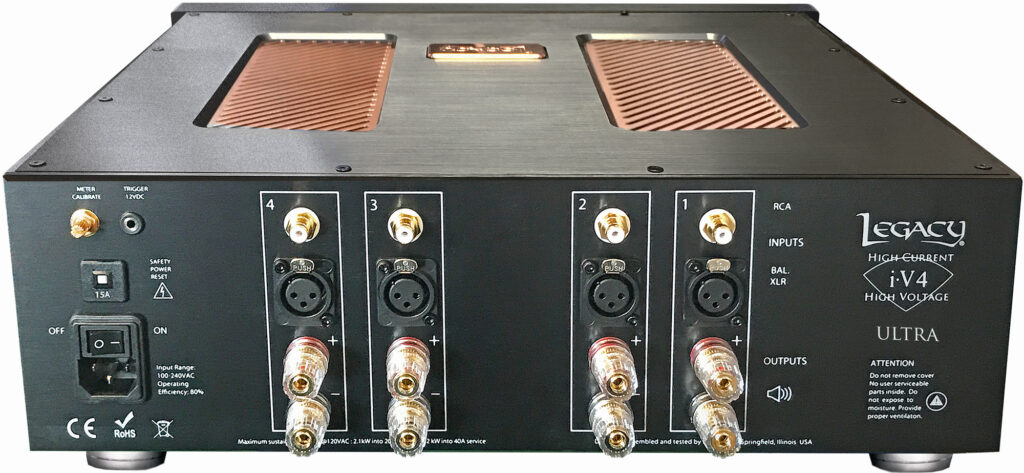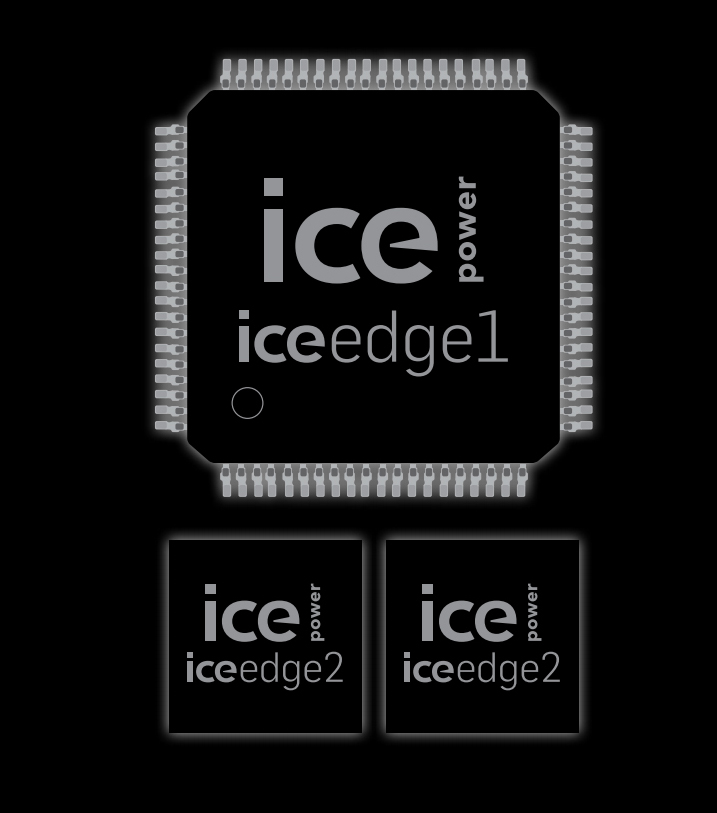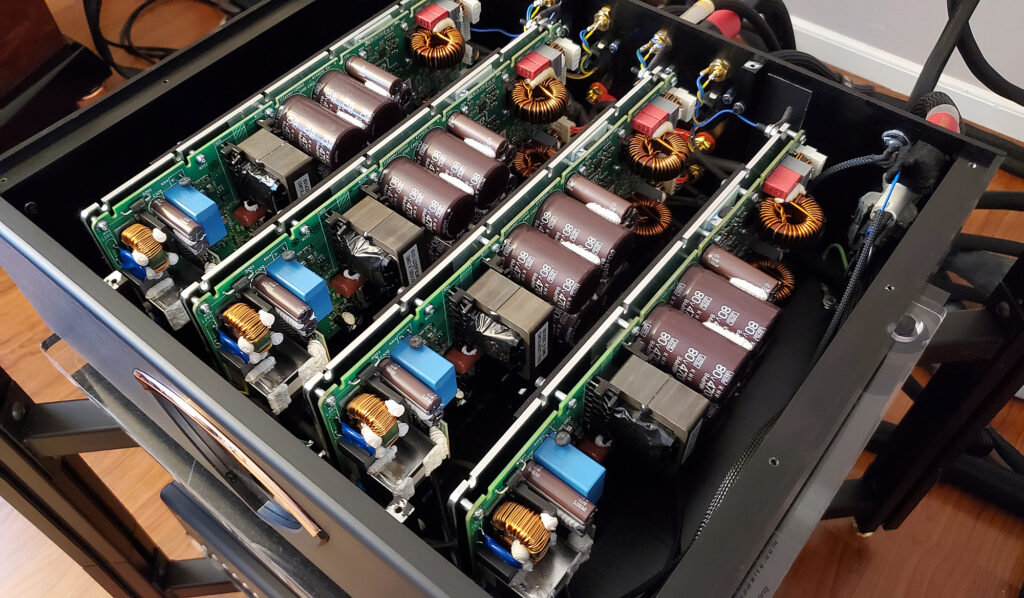Tour of features
Before we survey the topology of the i.V4 Ultra, a brief description of its features is in order. Legacy has created an amp with bling. It may not be a D’Agostino jewel, but it does capture some of that glamour. The black satin aluminum case with a Superman emblem-shaped meter topped with a peach-bronze highlight is a winner! Aesthetically I appreciate the absence of clutter on the face; the rocker On/Off switch is underneath the right front corner, lending an upscale feel to the amplifier. The coordinated bling of the bronze is carried through to the logo and vents atop, and even inside where one sees glimmers of the same color in each amp module. The meter indicates the voltage status of the amp, the large white needle resting over a blue LED when in operation, which turns yellow in standby. A small brass knob on the backside near the main Power switch controls positioning of the needle. The footers are high enough to allow fingers to slide under when moving it, something some other manufacturers have neglected to consider.
Legacy has held to their template for amp connection designations, preferring to label outputs by number. To hook up the speakers properly, one places cables according to the output’s associated number, as described in the Owner’s Manual. The unit is supplied with a stock 15A IEC, but aftermarket power cords are strongly recommended to enhance performance as the amp responds readily to them. Both RCA and XLR inputs are accepted on the i.V4 Ultra as well as the Wavelet. The posts are well marked, sturdy, and mercifully spaced far enough apart to accept bulkier spade terminations without fear of them coming into contact with each other. This design eschews a fuse in the circuit, as higher order safety features for the ICEedge modules protect against short circuit and thermal overload. When triggered, the amp is shut off, but depressing the SAFETY RESET button and cycling the power returns it to operation. A 12V trigger allows automatic turn On/Off.
Example of the changes to class D
Class D amplification is changing rapidly, with novel ideas being tried. Perusal of the landscape of class D development inevitably brings into view a newer technology, GaN (gallium nitride) FET transistors, which are said to offer better electron mobility than the standard MOSFET transistors. When I discussed the belief that GaN is thought of as the hottest new technology, Bill Dudleston, President and Founder of Legacy Audio, had the following to say:
GaN is a material that has been used in LEDs for more than two decades. It offers more potential than conventional Silicon material for semiconductors.
There is so much more to the execution of this design than merely output devices whether they be MOSFET, Si, or Gallium Nitride. It is carefully finessed for the audio realm with the ICEedge control platform. For example, there is an intended rise in the high frequency output just below 100kHz that eludes the HF sagging in the audible bandwidth that PWM designs exhibit.
There are independent power supplies for each of the output channels of the iV 4 Ultra. The differentiating forward filter is utilized for controlling a switching frequency of the system while the integrating forward filter is utilized for controlling the behavior of the amplifier system within an operating frequency band (e.g., audio band). The self-oscillating amplifier system exhibits improved performance in terms of open loop gain, reduced phase turn and improved robustness.
The situation seems akin to the temptation of audiophiles to draw universal conclusions about tube vs. solid state amplification. I get the excitement over GaN transistors (they are exciting), but their presence as parts, like tubes, do not ensure a holistically superior amplifier. Sometimes a novel technology is more a selling point than an actual advantage. It may be superior, but it may not. Only comparison can tell, which is something that overly enthusiastic audiophiles forget.
The advantage that ICEedge technology brings to class D (switching amps) is a patent on measuring and correcting dead time (time between switching on/off), which is particularly important in smoothing out slow signals (i.e., music). Bill states, “The present dead time compensation of each switching cycle was very key in the reduction of non-linearities and the neutral sonic character.”
Which is more important for superior sound, a GaN chip, or ICEedge? I cannot tell you, for I don’t have a GaN amp on hand, but the point is to not conclude a priori that a novel technology that is the hot topic supersedes other technological developments and/or design principles. Do such technological changes bring a better sound? You bet! Do not doubt that these are fundamentally different amps than the older class D you heard years ago.
It can be very difficult to convince someone by conversation alone that a fundamental shift has occurred in a class of amps. Is my writing an act of futility? Likely, in many cases the answer is yes, because all those who remain skeptical, who resist, will most likely not re-anchor. But those who are not so jaded will try, will weigh anchor, sail into a blissfully new experience, and re-anchor their perception of class D at a new vista. I suspect that our cynical readers think I’m selling here, fluffing the facts, overstating the case. It’s a matter of belief, and you have to decide if I am trustworthy. You either distrust and stagnate, or you mentally weigh anchor and come along!
Pending sea change!
With the advent of the latest class D amplifiers a seemingly sudden, and potentially devastating, transition has come; a sea change of class D has swept in from the sea! Tucked away in the folds of Europe, a team of more than 40 engineers at ICEpower have been contributing to the equivalent of a tectonic event, setting off a wave of class D development globally that is breaking over the industry. I believe it will ultimately bring the decline of class A, A/B, SET, Triode, Pentode —all of them. For years the signs of the shift have been present, but who listened, who really believed? Who among the amp makers fastidiously studied class D, and made arrangements to be among the survivors? A few did, but most did not.
I am impressed by a recent scholarly work on the global Flood — yes, the one mentioned in the Bible book of Genesis. Before scoffing, consider whether you, like the author, are a trained geologist, and with decades of work with some of the largest oil companies on earth. Now that your ego is checked, I submit for your consideration the book Carved in Stone by Dr. Tim Clarey. It presents a coherent scientific theory of the catastrophic collapse of the sea floor, subsequent runaway subduction of it into Earth’s core, and displacement of phenomenal amounts of water from shallow seas of the early earth in tsunamis that swept the low-lying continents, ultimately forming new features, such as the high mountains! Maps and charts of lithographic strata, based on the petroleum industry’s oil and gas well drilling data, lay out the mega sequences (tsunamis) that rocked the world. It discusses thoroughly the lithosphere, asthenosphere and other aspects of the earth’s lithography, showing precisely what kind of rock was deposited by global tidal waves, and where. Along the way it discusses such curiosities as “gigantism,” the enormous size of flora and fauna of the pre-Flood world preserved in the fossil record. Anyone who wants to see rock hard scientific evidence of the Deluge needs to see this work!
Belief is an interesting phenomenon. The presence of strong evidence is not sufficient to engender belief; reliance upon the source can be pivotal in the mind of the believer. Scientifically supported things can be rejected because of disdain of the source, while an alternative source may engender confidence, even in poorly supported, wildly speculative claims! Confidence in the source is important to both religious and scientific belief, as it determines the acceptance of what one cannot independently verify. I am about to tell you some things about class D amplification that you may not wish to believe. Some members of the community will be tempted to dismiss my thoughts because they know more about amplifier design, and others will question my motives. You may decide I am not a credible source. However, it will not change the well-reasoned discussion and even-handed comparisons that follow, laying the groundwork for a mega sequence of the destruction of the aforementioned classes of amps. The world of HiFi amplification is being rocked!
- ← Previous page
- (Page 2 of 5)
- Next page →




Legacy does not design or build their amplifiers. As such, replacement parts are a wish, as they don’t stock parts.
Good point, FG. There’s a lot to admire about designing and building your own high or lowbrow hi-fi. I’m with them. On the other hand, who’s lookin for replacement parts, and how often? Nobody. That’s who.
Fernando,
God’s Peace,
You seem to not know that Legacy Audio has serviced and provided parts for their amps for the entire 38 years of their business. Even Legacy’s early designs are still serviced by Doug Dale of Coda.
I suspect that there will be much unhappiness in the audiophile community and the industry over what I have written about the state of the other genres of amps relative to these new designs in class D that simply are outperforming them. However, the community will properly be informed about the high quality products and service from manufacturers such as Legacy Audio.
Blessings,
Douglas Schroeder
Have you heard Lyngdorf integrated amplifier?
Jyrki,
God’s Peace,
I do not believe I have heard it. Perhaps if it is at AXPONA someday I may hear it.
Blessings,
Douglas Schroeder
As a long-term Legacy customer, well over 15 years I stand with Doug on this one in that the earlier post is not correct with regards to Legacy not standing behind their products whether jointly designed as is the case with their prior amps as well as their current amps, the Wavelet, or their fully in-house designed speakers. I’ve been to Legacy many times to visit, listen to new and older speakers alike and I can tell you first hand that a large portion of space is current and prior generation parts and a good number trade-in speakers in excellent condition going back many years waiting for their next owner . Legacy’s long-term support of their customers is a well-established fact IMHO.
Douglas,
Did you happen to try the V4 Ultra with the Pass active crossover on the PureAudioProject speakers?
Tom
Tom,
God’s Peace,
That is a good and pertinent question. I have not yet tried that combo. One of the reasons why is that I moved on to do work on the PAP Quintet 15 Horn1, and a review of it will appear soon. It uses a different crossover, so my time with the i.V4 Ultra and the Trio15 Horn1 was somewhat limited.
I will not say definitively, but I would presume that if used with the i.V4 Ultra amp the active crossover for the speakers would benefit similarly to the passive version. I do not envision a scenario where the i.V4 Ultra was not a boon to the active crossover and Trio15 performance. I would anticipate benefits in line with the changes for the speaker in passive mode, but with the advantages of the active x-over.
Blessings,
Douglas Schroeder
As a Legacy owner for many years, I have found them quite responsive to emails and even phone calls surrounding various questions about their product, system suggestions and also support of their product.
Having owned a pair of Legacy Whisper XD’s, then before that a pair of Legacy Focus I have found their service second to none. When I purchased the XD’s, I had several questions regarding the how to hook up a VTL 2.5 with a home theatre bypass. Sent the email out on a weekend to Bill D. the president of Legacy. I received a very detailed answer how to integrate into my HTR a few short hours later.
Unheard of customer service. They are the best company I have ever dealt with in my 50 years of my audio journey.
Would never have a second thought about purchasing any of their products or be concerned about any service issues now or in the distant future.
Ok, I believe the waythis review is written is the way reviews should be period.
I have Bowers and Wilkins 802 D3 for fronts, 804 D3 for the rear and the HTM81 D4 as center. I’m currently running this with a Parasound Halo A51 5ch amp. I’m also considering putting in ceiling speakers which will require new power and was thinking about the Parasound Halo A31, which I would use for the three front speakers and the 5ch amp for the rear and ceiling speakers.
But now that I have red the Legacy Audio i-v7 review, I’m considering selling my Parasound and go with the i-v7. What is your take and option on this?
Yanick,
God’s Peace,
Thank you for the vote of confidence regarding the review! I am happy that it has been helpful.
I have not done a side by side comparison between the Halo amplifier and the i.V, so I will not speculate on which I would prefer. I will say that the i.V4 Ultra continues to anchor the best systems I have ever built and holistically is superior to the A/B amps I have reviewed, and for that matter, the tube amps I have reviewed as well. As I said in my review, it would likely take an entirely new technology in those classes of amps to make it worth my time to review them. I know of one company doing something unusual and I am in line to review it, but I am not at liberty to discuss it. I don’t think it would be applicable to your situation, as the amp would be much more expensive and not multi-channel – at least not that I know.
I think the i.V7 would be superb for a surround system. I use my surround system so seldom, literally once every few months, that it is not worth upgrading the lowly Rotel multichannel amp in use. However, if I were doing movies constantly, I likely would have already upgraded to several more channels of Legacy’s i.V amplifier.
I have had zero technical/operational issues since the review was published. It has been very reliable.
The i.V4 Ultra is a fantastic amp for passively bi-amping main speakers. I listen to 2-channel 99%+ of the time, so they remain configured that way, versus shifting other channels for surround.
Blessings,
Douglas Schroeder
Dagogo.com